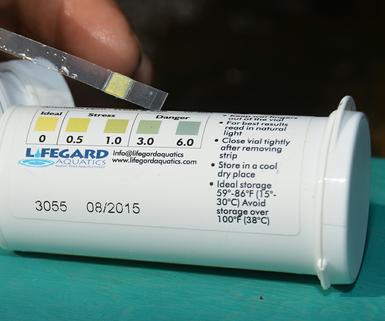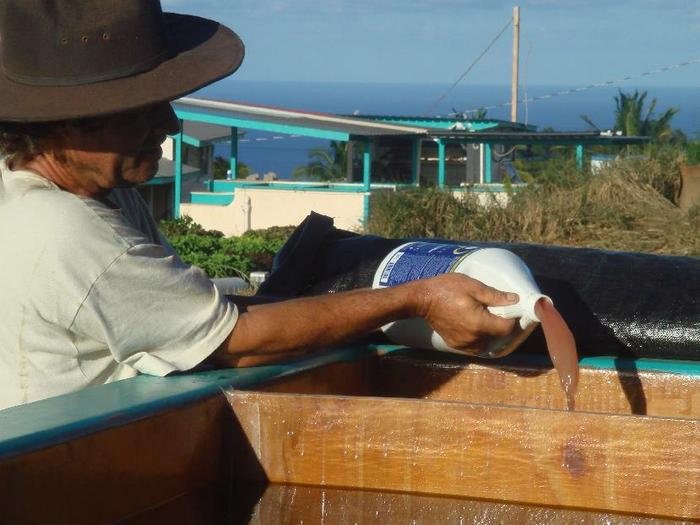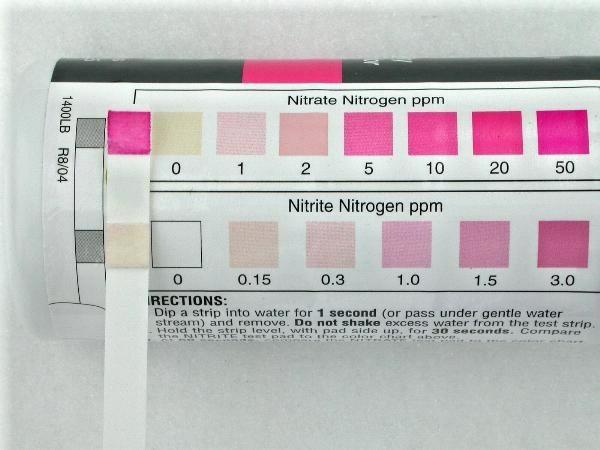Potential Startup Problems
FIRST: Too Much Ammonia Will Stop The System Startup! Your system will guaranteed fail to start if your ammonia level is over 6 ppm, and may even fail if it’s over 3 ppm. Nitrifying bacteria are sensitive to ammonia levels in the water above 3 ppm, which will inhibit their growth or kill them outright. When starting your system with a nitrifying bacteria inoculant such as ProLine, your system must have less than 3 ppm ammonia, preferably 1 ppm ammonia.
(Below) Ammonia test strips sensitive down to 0.5 ppm.
WARNING: IF YOU HAVE MORE THAN 3 PPM AMMONIA IN YOUR SYSTEM, YOU WILL INHIBIT THE BACTERIA, AND THERE WILL BE NO SYSTEM STARTUP.
The only thing you can do if you have a system with 6 ppm ammonia or higher is to dump (yes, dump out onto the ground!) about 3/4 of the system water. The easy way to do this is to turn off the water pump, cap the pipe that leads to the hydroponics troughs so that no water goes out there, put a hose (the bigger the better) into the troughs, and siphon the trough water off downhill (hopefully you have a hill to do this with, otherwise just pump it out).
Then refill the troughs with water containing NO ammonia, let it sit for 24 hours to dechlorinate if it’s chlorinated tap water, then remove the cap and pump for six to twelve hours to fully circulate and mix the new water with the high-ammonia water remaining in the fish tank. This dilutes your system water ammonia levels to around 1-2 ppm (check and confirm it this time with the test strips to make sure). Now put a new gallon of ProLine bacterial inoculant in. Putting forty or fifty gallons of system water from an operating aquaponics system that you are absolutely certain has no diseased fish, no diseased plants, no parasites, no crawfish, and no duckweed into your system will work just as well as the Proline inoculant.
There is ONE sneaky thing to watch out for here: if your “city water” is sanitized with chloramines instead of chlorine, and you do not use a “total chlorine” test to test for chlorine/chloramines, you will find that your ammonia strips will show the “amine” portion of the chloramine as if it were ammonia. This will make it seem to you as if your incoming system water has ammonia in it, while the truth is you simply didn’t use the correct total chlorine test to test for chlorine/chloramines in your incoming water.
(Below) Inoculating a 24,000 gallon commercial aquaponics system with a SINGLE $42 gallon of ProLine freshwater nitrifying bacteria.
SECOND: Another Way to Foul Up System Startup: Some of our students started their systems with the covers off the fish tank and the rafts off the troughs. This allowed lots of green algae to grow, because soon after inoculation, there were nitrates for it to grow on. This created high ammonia levels of 6 ppm or more when the algae died and started to decompose in the bottoms of the troughs. How to fix: start your system with the rafts on the troughs, and only take them off to modulate an actual nitrite spike, not because you are “expecting one”.
If you make this mistake (even though we’ve warned you here), fix it by dumping three quarters of the green system water to get rid of the algae and the ammonia, refill with clean water, and cover the troughs this time! After a while, your system will settle down and you will see normal levels of 1-2 ppm ammonia, 0.25 to 1 ppm nitrites, and 1-20 ppm nitrates during your startup.
Bad Inoculant Bacteria, Or Something Else?
We frequently hear: “Our inoculant was bad” from students. We have heard many times how their inoculation “didn’t work”. We know that most of the time, it’s probably because their “live” bottle of inoculant bacteria sat for a few hours on a 115-degree or a 28-degree loading dock, and the bacteria are fried or frozen. However, that’s not the only possible cause of this.
You can safely conclude your inoculant is bad after you’ve verified several things first. The first thing you must do is use the Hach 27454 test strips, which test down to 0.15 ppm nitrites, and 1 ppm nitrates. This is because using a less sensitive test strip can lead you to think there are no nitrites or nitrates, when what’s really happening is that you’re having a startup that simply has low levels of those two. Often the nitrite level only gets up to 1 ppm, and the nitrate level up to 10 ppm during a “mild” startup. Under these conditions, a strip that only reads down to 2 ppm nitrites and down to 20 ppm nitrates will remain “white”; and it won’t even show a color change at these low levels. How do we know? 🙂
(Below) Nitrite/Nitrate test strips sensitive down to 0.15/1 ppm.
Then check your system water temperature and ammonia level. If the water temperature is over 65 degrees, and if the ammonia is 2 ppm or less, you have optimum conditions for startup. If you are also using the sensitive Hach test strips, you can safely conclude a couple of weeks after inoculation that it was a bad batch of bacteria.
However, if you have 54 degree water, that is so cold that even a good bottle of inoculant bacteria will respond veeery sloooowly, if at all. The water temperature should be 65 degrees or above to have a reasonable chance at a normal startup. If you have 5 to 6 ppm ammonia, that is so much ammonia that it inhibits the nitrifiers and they will “hide in the cracks”. The good news about high ammonia levels such as this, is that the nitrifiers respond well after dumping three-quarters of the system water and refilling (to get rid of excess ammonia), and nitrites and nitrates appear a few days after reducing the ammonia below 3 ppm. There are ammonia-reducing chemicals such as AmQuel; we’ve never used them, and don’t recommend them.
On our farm, we have had the best luck with the $42 gallon of ProLine bacteria from Aquatic EcoSystems. When we inoculated our first system, we purchased the $315 refrigerated “high concentration” gallon of inoculant from them, with the $215 overnight UPS refrigerated shipping; for a total of $530 for a gallon of inoculant bacteria! After putting it in a system that had fish in it, 0.5 ppm ammonia, and 75 degree water, we saw no nitrites nor nitrates over the next 3 weeks using the sensitive Hach test strips. Yow! Dead $500 gallon of inoculant!
Just about that time, the non-refrigerated $42 gallon of ProLine inoculant bacteria showed up in the surface freight with the other 600 pounds of our order from Aquatic Eco. We put it in, and the system showed nitrites two days later and nitrates three days later.
Leave a Reply